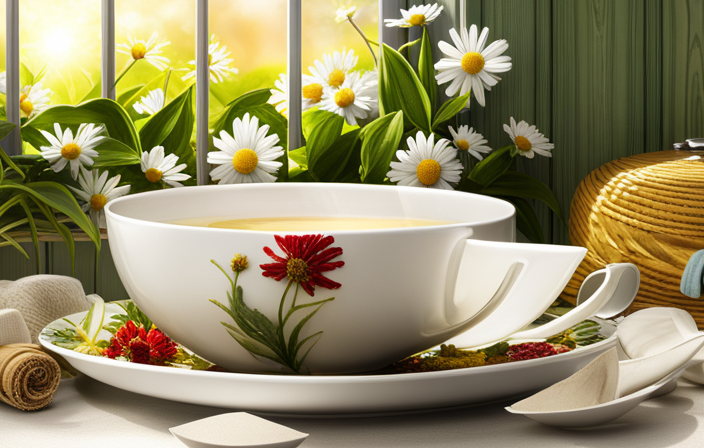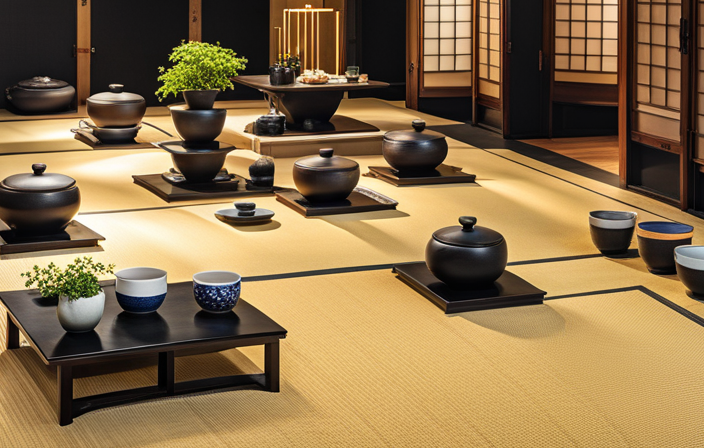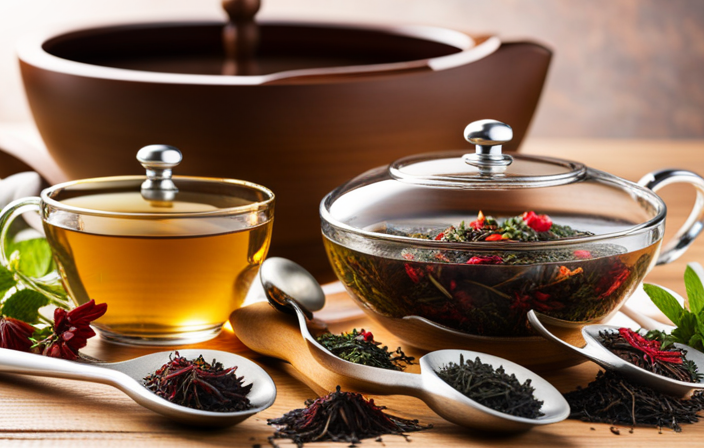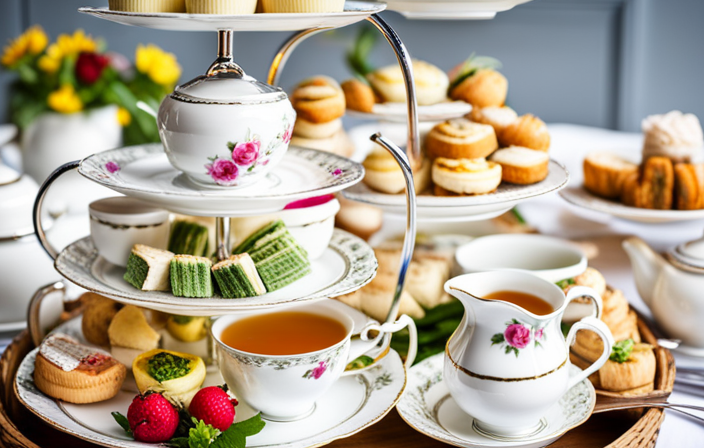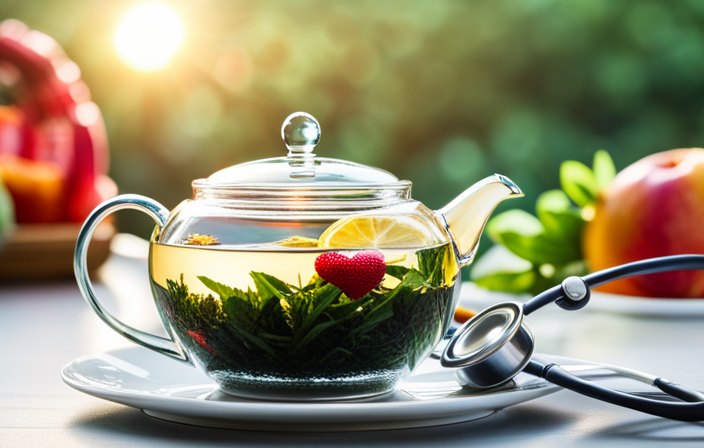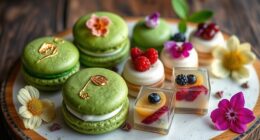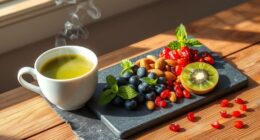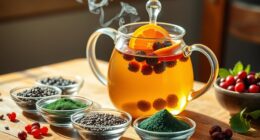I’m here to spill the tea on how to level up your skincare game!
With these 7 incredible ways to incorporate tea into your routine, you’ll be sipping on glowing, flawless skin in no time.
From tea-infused cleansers to DIY toners and moisturizers, these tips will have you feeling like a true skincare connoisseur.
So grab your favorite cuppa and get ready to indulge in some serious self-care.
Your skin will thank you!
Key Takeaways
- Tea-infused cleansers and scrubs provide antioxidant and anti-inflammatory properties, soothing and nourishing the skin.
- Tea face masks and eye compresses combat free radicals, hydrate the skin, and reduce puffiness and dark circles.
- Tea-based exfoliators and DIY tea toners are natural and gentle options that combat free radicals, reduce inflammation, and provide hydration and nourishment.
- Tea-infused facial steams promote circulation, hydrate the skin, relax facial muscles, and provide deep cleansing. Additionally, proper tea storage is important for maintaining freshness and taste.
Tea-Infused Cleansers
I’m loving the tea-infused cleanser I recently tried – it leaves my skin feeling refreshed and rejuvenated!
Tea-infused skincare products have gained popularity due to their numerous benefits. These cleansers are formulated with tea extracts that provide antioxidant and anti-inflammatory properties, helping to soothe and nourish the skin.
Tea-infused serums are excellent for hydrating and brightening the complexion. They contain potent antioxidants that protect the skin from environmental stressors and promote a youthful glow.
On the other hand, tea-infused body scrubs gently exfoliate the skin, removing dead cells and impurities, leaving it smooth and soft. The tea extracts in these scrubs also have soothing properties, making them perfect for individuals with sensitive skin.
Incorporating tea-infused cleansers, serums, and body scrubs into your skincare routine can provide numerous benefits and leave your skin feeling refreshed and revitalized.
Tea Face Masks
After applying a tea face mask, I like to relax for 15 minutes and let the ingredients work their magic.
Tea face masks are a great addition to any skincare routine, as they offer a multitude of benefits for the skin. The natural antioxidants found in tea help to combat free radicals, which can lead to premature aging and skin damage. Additionally, tea face masks can help to soothe and hydrate the skin, leaving it feeling refreshed and rejuvenated.
For an extra treat, you can also use tea eye compresses while wearing your face mask. Simply soak two tea bags in warm water, then place them over your closed eyes for 10 minutes. This will help to reduce puffiness and dark circles.
Now, let’s move on to the next topic: tea-based exfoliators.
Tea-Based Exfoliators
During my skincare routine, I like to gently exfoliate my face with tea-based exfoliators for a refreshing and revitalizing effect. Tea-based scrubs are not only natural and gentle on the skin, but they also offer numerous benefits. The antioxidants in tea help to combat free radicals and reduce inflammation, leaving the skin looking brighter and healthier. Additionally, tea infused serums can provide hydration and nourishment, as well as target specific skincare concerns.
Here is a table showcasing some popular tea ingredients and their benefits in skincare:
| Tea Ingredient | Benefits |
|---|---|
| Green Tea | Rich in antioxidants, reduces inflammation and fights acne |
| Chamomile | Soothes and calms irritated skin, reduces redness |
| Rooibos | Hydrates and nourishes, improves skin elasticity |
| White Tea | Anti-aging properties, reduces fine lines and wrinkles |
Incorporating tea into your skincare routine is a simple yet effective way to enhance your natural beauty and promote overall skin health. So why not give it a try and enjoy the rejuvenating properties of tea?
DIY Tea Toners
While I’m already enjoying the benefits of tea-based exfoliators, I’m excited to explore DIY tea toners to further enhance my skincare routine. Tea toners are a great way to revitalize and balance the skin, providing a refreshing boost of hydration and nourishment.
Here are three simple yet effective DIY tea toners you can easily incorporate into your skincare regimen:
-
Green Tea Mist: Brew a strong cup of green tea and let it cool. Transfer it to a spray bottle and spritz it onto your face throughout the day for a refreshing and rejuvenating mist.
-
Chamomile Toner: Steep chamomile tea in hot water, then strain and let it cool. Apply it to your face using a cotton pad to soothe and calm irritated skin.
-
Rosewater and Black Tea Toner: Combine rosewater and brewed black tea in equal parts. Apply it to your face using a cotton pad to tighten pores and reduce inflammation.
Now that we’ve explored DIY tea toners, let’s move on to the next topic: tea-infused facial steams.
Tea-Infused Facial Steams
Tea-infused facial steams are a wonderful addition to any skincare routine. They provide numerous benefits such as opening up pores, promoting circulation, and hydrating the skin.
When choosing teas for your facial steams, opt for those that are gentle and soothing, such as chamomile or green tea, to ensure maximum benefits for your skin.
Benefits of Facial Steams
I love how facial steams open up my pores and leave my skin feeling refreshed and rejuvenated. Facial steaming has numerous benefits for the skin, making it an essential part of my skincare routine. Here are three reasons why facial steams are beneficial:
-
Deep Cleansing: Facial steams help to unclog pores and remove dirt, oil, and impurities from the skin. The warm steam helps to loosen the buildup, making it easier to cleanse the skin effectively.
-
Hydration Boost: Steam helps to hydrate the skin by increasing blood circulation and promoting the production of natural oils. This can leave the skin looking plump and radiant.
-
Relaxation and Stress Relief: Facial steams not only benefit the skin but also provide a calming and soothing experience. It can help to relax facial muscles and reduce stress, leaving you feeling refreshed and rejuvenated.
To enhance the benefits of facial steams, I like to incorporate herbal tea blends. The steam infused with herbal properties can provide additional nourishment and soothing effects to the skin.
Tea Selection Tips
One important tip for selecting teas for facial steams is to consider the steeping time, as different teas require varying amounts of time to release their beneficial properties. Green tea, for instance, should be steeped for about 1-2 minutes to prevent it from becoming bitter and to preserve its antioxidants. On the other hand, herbal teas like chamomile and lavender can be steeped for longer periods, around 5-10 minutes, to fully extract their soothing and calming properties.
When it comes to tea brewing techniques, it’s essential to use filtered or purified water to ensure the best quality infusion. Additionally, using loose tea leaves instead of tea bags allows for better control over the steeping process and results in a more flavorful steam.
To fully enjoy the benefits of tea, proper storage is crucial. Keep your teas in airtight containers away from light, heat, and moisture. This helps maintain their freshness and extends their shelf life. Remember to store different types of tea separately to prevent them from absorbing each other’s flavors.
Tea Eye Compresses
How often should I use tea eye compresses to reduce puffiness and dark circles?
Tea eye compresses can be a great addition to your skincare routine, as they have a soothing and calming effect on the delicate skin around the eyes.
Here are three important things to keep in mind when using tea eye compresses:
-
Frequency: It’s recommended to use tea eye compresses 2-3 times a week for best results. This allows your skin to benefit from the properties of the tea without overdoing it.
-
Preparation: Brew a strong cup of tea using your favorite tea leaves or tea bags. Let it cool down to room temperature before soaking a clean, soft cloth in it.
-
Application: Gently place the tea-soaked cloth over your closed eyes and relax for 10-15 minutes. This can be a great opportunity to practice relaxation techniques, such as deep breathing or meditation.
Using tea eye compresses regularly can help reduce puffiness and dark circles, giving your eyes a refreshed and rejuvenated appearance.
Tea-Infused Moisturizers
I love using tea-infused moisturizers because they provide a natural and refreshing boost to my skin, while also keeping it hydrated and nourished.
Tea-infused serums and face oils have become increasingly popular in skincare routines, and for good reason. These products are infused with the goodness of tea, which is rich in antioxidants and other beneficial compounds.
Green tea, for example, is known for its anti-inflammatory properties, making it an excellent choice for soothing irritated skin. Black tea, on the other hand, contains caffeine, which can help tighten the skin and reduce puffiness.
When used in moisturizers, these tea-infused ingredients can help promote a brighter complexion and protect the skin from environmental damage.
Frequently Asked Questions
Can I Use Any Type of Tea for My Tea-Infused Cleanser?
Yes, you can use any type of tea for your tea-infused cleanser. Different types of tea, such as green tea, chamomile, and black tea, have various benefits for your skin.
Green tea is rich in antioxidants and can help reduce inflammation and acne.
Chamomile tea is soothing and can calm irritated skin.
Black tea is great for firming and tightening the skin.
Incorporating tea into your skincare routine can provide natural and nourishing benefits for a healthy complexion.
How Often Should I Use a Tea Face Mask?
When it comes to using a tea face mask, it’s important to find the right balance. Using it too often can be harsh on your skin and lead to irritation. It’s best to use a tea face mask once or twice a week, depending on your skin type and its sensitivity.
Additionally, choosing the right tea for your face mask is crucial. Some teas, like green tea or chamomile, have calming properties, while others, like black tea, can be more invigorating for the skin.
Are Tea-Based Exfoliators Suitable for All Skin Types?
Tea-based exfoliators can be suitable for all skin types due to their numerous benefits. Green tea, for example, is rich in antioxidants that can help improve the appearance of dull and tired skin. However, for those with sensitive skin, alternatives like oatmeal or honey-based exfoliators can be gentler options.
It’s important to consider your skin’s specific needs and sensitivity level when incorporating tea-based exfoliators into your skincare routine.
Can I Use Any Type of Tea for My DIY Tea Toner?
Sure, you can use any type of tea for your DIY tea toner. Different types of teas have various benefits for skincare.
For example, green tea is known for its antioxidant properties, which can help reduce inflammation and protect against free radicals.
Chamomile tea is soothing and can calm irritated skin.
Rooibos tea is rich in vitamins and minerals, promoting healthier skin.
Tea-infused products like face masks and serums are also great for achieving glowing skin.
How Long Should I Steam My Face With a Tea-Infused Facial Steam?
When it comes to steaming my face with a tea-infused facial steam, I always make sure to do it for the right amount of time. To properly prepare a tea-infused facial steam, you’ll need to boil water, add your choice of tea leaves, and let it steep for a few minutes. The benefits of using tea-infused steam for facial cleansing are numerous. It helps to open up the pores, remove impurities, and promote circulation. Simply lean over the steaming pot for about 5-10 minutes, allowing the steam to work its magic on your skin.
Conclusion
Incorporating tea into your skincare routine is a simple yet effective way to enhance your complexion and achieve a natural glow.
From tea-infused cleansers to DIY toners and moisturizers, there are endless possibilities to explore.
So why not sip on a cup of tea while treating your skin to its antioxidant-rich goodness?
Remember, just like a warm cup of tea soothes the soul, incorporating tea into your skincare routine can soothe and nourish your skin, leaving you feeling refreshed and rejuvenated.

